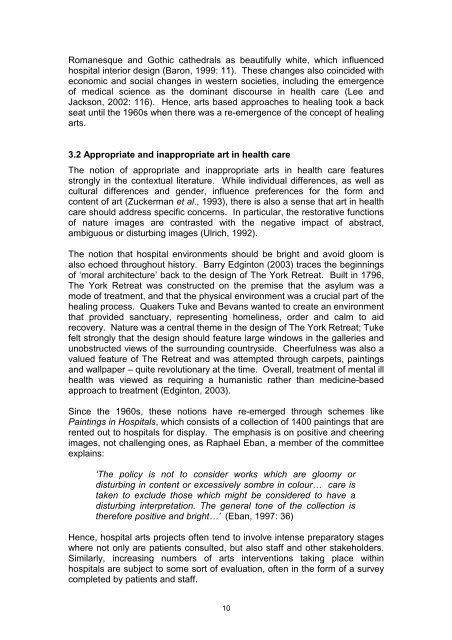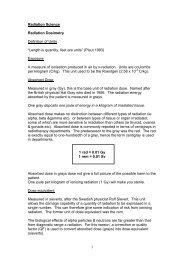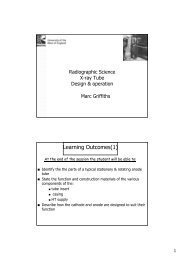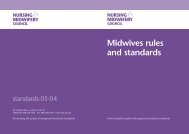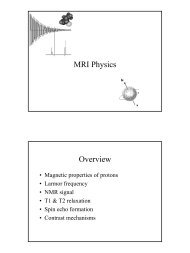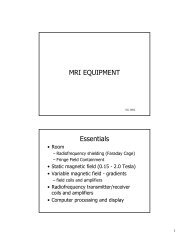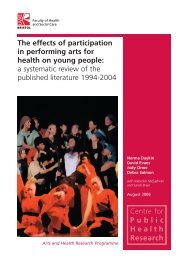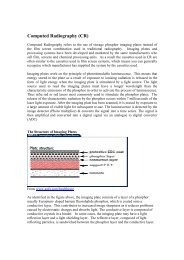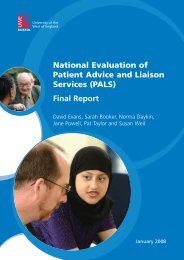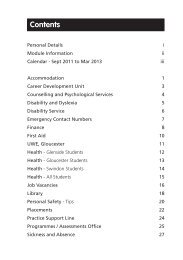Romanesque and Gothic ca<strong>the</strong>drals as beautifully white, which influencedhospital interior design (Baron, 1999: 11). These changes also coincided wi<strong>the</strong>conomic and social changes in western societies, including <strong>the</strong> emergence<strong>of</strong> medical science as <strong>the</strong> dominant discourse in health care (Lee andJackson, 2002: 116). Hence, arts based approaches to healing took a backseat until <strong>the</strong> 1960s when <strong>the</strong>re was a re-emergence <strong>of</strong> <strong>the</strong> concept <strong>of</strong> healingarts.3.2 Appropriate and inappropriate art in health careThe notion <strong>of</strong> appropriate and inappropriate arts in health care featuresstrongly in <strong>the</strong> contextual literature. While individual differences, as well ascultural differences and gender, influence preferences for <strong>the</strong> form andcontent <strong>of</strong> art (Zuckerman et al., 1993), <strong>the</strong>re is also a sense that art in healthcare should address specific concerns. In particular, <strong>the</strong> restorative functions<strong>of</strong> nature images are contrasted with <strong>the</strong> negative impact <strong>of</strong> abstract,ambiguous or disturbing images (Ulrich, 1992).The notion that hospital environments should be bright and avoid gloom isalso echoed throughout history. Barry Edginton (2003) traces <strong>the</strong> beginnings<strong>of</strong> ‘moral architecture’ back to <strong>the</strong> design <strong>of</strong> The York Retreat. Built in 1796,The York Retreat was constructed on <strong>the</strong> premise that <strong>the</strong> asylum was amode <strong>of</strong> treatment, and that <strong>the</strong> physical environment was a crucial part <strong>of</strong> <strong>the</strong>healing process. Quakers Tuke and Bevans wanted to create an environmentthat provided sanctuary, representing homeliness, order and calm to aidrecovery. Nature was a central <strong>the</strong>me in <strong>the</strong> design <strong>of</strong> The York Retreat; Tukefelt strongly that <strong>the</strong> design should feature large windows in <strong>the</strong> galleries andunobstructed views <strong>of</strong> <strong>the</strong> surrounding countryside. Cheerfulness was also avalued feature <strong>of</strong> The Retreat and was attempted through carpets, paintingsand wallpaper – quite revolutionary at <strong>the</strong> time. Overall, treatment <strong>of</strong> mental illhealth was viewed as requiring a humanistic ra<strong>the</strong>r than medicine-basedapproach to treatment (Edginton, 2003).Since <strong>the</strong> 1960s, <strong>the</strong>se notions have re-emerged through schemes likePaintings in Hospitals, which consists <strong>of</strong> a collection <strong>of</strong> 1400 paintings that arerented out to hospitals for display. The emphasis is on positive and cheeringimages, not challenging ones, as Raphael Eban, a member <strong>of</strong> <strong>the</strong> committeeexplains:‘The policy is not to consider works which are gloomy ordisturbing in content or excessively sombre in colour… care istaken to exclude those which might be considered to have adisturbing interpretation. The general tone <strong>of</strong> <strong>the</strong> collection is<strong>the</strong>refore positive and bright…’ (Eban, 1997: 36)Hence, hospital arts projects <strong>of</strong>ten tend to involve intense preparatory stageswhere not only are patients consulted, but also staff and o<strong>the</strong>r stakeholders.Similarly, increasing numbers <strong>of</strong> arts interventions taking place withinhospitals are subject to some sort <strong>of</strong> evaluation, <strong>of</strong>ten in <strong>the</strong> form <strong>of</strong> a surveycompleted by patients and staff.10
Notions <strong>of</strong> appropriate and inappropriate art in health care feature strongly in<strong>the</strong> literature reviews we identified and are discussed in Section 5 below.3.3 The diversity <strong>of</strong> arts and health activityThe review <strong>of</strong> <strong>the</strong> literature identified a diverse range <strong>of</strong> arts for healthactivities, including: aes<strong>the</strong>tic considerations in building design, inclusion <strong>of</strong>commissioned artworks in health care settings, and participatory and<strong>the</strong>rapeutic patient arts. Hence, arts for health encompasses a broad range <strong>of</strong>disciplines including: evidence based design, public arts, arts for health andestablished arts <strong>the</strong>rapies.Design and environmentThe impact <strong>of</strong> building design and environment is a key <strong>the</strong>me. Key aes<strong>the</strong>ticand functional considerations include: Engendering a welcoming, calming and non-institutional atmosphere. Distracting patients from stress and anxiety. Helping people to navigate <strong>the</strong>ir way round hospitals. Fostering a sense <strong>of</strong> ownership and pride in public buildings.(Scher, 1996; Scher, 2000; Miles, 1994; NHS Estates, 2002a).Participatory and patient artsPatient arts in <strong>the</strong> form <strong>of</strong> art and music <strong>the</strong>rapy are well established in <strong>the</strong>NHS, with music <strong>the</strong>rapy <strong>the</strong> most recent discipline to gain <strong>the</strong> stateregistration status through <strong>the</strong> Health Pr<strong>of</strong>essions Council in 1997. O<strong>the</strong>rparticipatory arts are more emergent and less well regulated. The aims <strong>of</strong><strong>the</strong>rapeutic and patient arts to some extent overlap, although <strong>the</strong> review hasidentified a need for a clearer understanding <strong>of</strong> <strong>the</strong>ir respective contributions(Arts Council <strong>England</strong>, 2004). While <strong>the</strong>rapeutic arts are <strong>of</strong>ten linked withclinical outcomes, some patient participatory arts emphasise aes<strong>the</strong>tic goals.For example, organisations like START (Sheltered Training in Art) inManchester focus on developing artistic ability in mental health service users.At START’s inception, none <strong>of</strong> <strong>the</strong> staff had psychiatric qualifications so<strong>the</strong>rapy was not an objective. The focus has been very much on <strong>the</strong>production <strong>of</strong> high-quality artwork and it is claimed that START’s artistic outputalone makes <strong>the</strong>m directly comparable to o<strong>the</strong>r arts and environmental artsagencies (Brown, 1997). Work produced in START’s studios has beenexhibited in diverse arenas and has won numerous prizes, including <strong>the</strong>recent <strong>University</strong> College London Arts in Health Award for 2004.In some documents, tensions between public, participatory and <strong>the</strong>rapeuticarts emerge. Hence, key questions arise about <strong>the</strong> value <strong>of</strong> participation, <strong>the</strong>judgement <strong>of</strong> quality, and <strong>the</strong> role <strong>of</strong> pr<strong>of</strong>essional artists in health care. PeterSenior, who leads <strong>the</strong> Manchester Arts for Health organisation, which helps to11
- Page 1: The impact of visual artsand design
- Page 5 and 6: Table of ContentsExecutive Summary.
- Page 7 and 8: 10. Results of Non-intervention Stu
- Page 9 and 10: Executive Summary(i)(ii)(iii)This r
- Page 11: are unlikely to receive consensual
- Page 15 and 16: 2. Systematic Review Methodology an
- Page 17: 3. Overview of Contextual Literatur
- Page 21: Identifying these different dimensi
- Page 24 and 25: Support for the role of arts in hea
- Page 26 and 27: Arts Council England; the recently
- Page 28 and 29: consequent difficulty of relating a
- Page 30 and 31: outcomes including depression, elev
- Page 32 and 33: Inappropriate art can worsen patien
- Page 34 and 35: outcomes are also addressed, althou
- Page 37 and 38: 6. Methodological Characteristics o
- Page 39 and 40: General issuesThe research on the i
- Page 41 and 42: was an opinion survey or 2200 staff
- Page 43: There are several non-experimental
- Page 46 and 47: Another study by Duncan (2003) used
- Page 48 and 49: The research also suggests a number
- Page 50 and 51: wards and three female wards, inclu
- Page 52 and 53: the new wards did not allow patient
- Page 54 and 55: Patients with stressful conditions,
- Page 56 and 57: The author suggests that participat
- Page 58 and 59: and Douglas, 2005). Qualitative met
- Page 60 and 61: health care environment, issues als
- Page 62 and 63: Creating uplifting environments and
- Page 64 and 65: esearch. Critical appraisal of the
- Page 66 and 67: Coultier, A.C. (2005) What is the e
- Page 68 and 69:
McAuslane, L. and Sperlinger, D. (1
- Page 70 and 71:
Ulrich, R. (1992) How design impact
- Page 72 and 73:
Appendix 2. Search terms used in th
- Page 74 and 75:
Appendix 4. Overview of the search
- Page 76 and 77:
Appendix 6: Data Extraction SheetSt
- Page 78 and 79:
Staricoffand Loppert(2003)(unrepres
- Page 80 and 81:
Passini etal. (1998)Schofield(2003)
- Page 82 and 83:
Appendix 9. Overview of studies of
- Page 84 and 85:
BenjaminandSpector(1990)Assessment
- Page 86 and 87:
y Bryan Lawson and Michael Phiri, i


